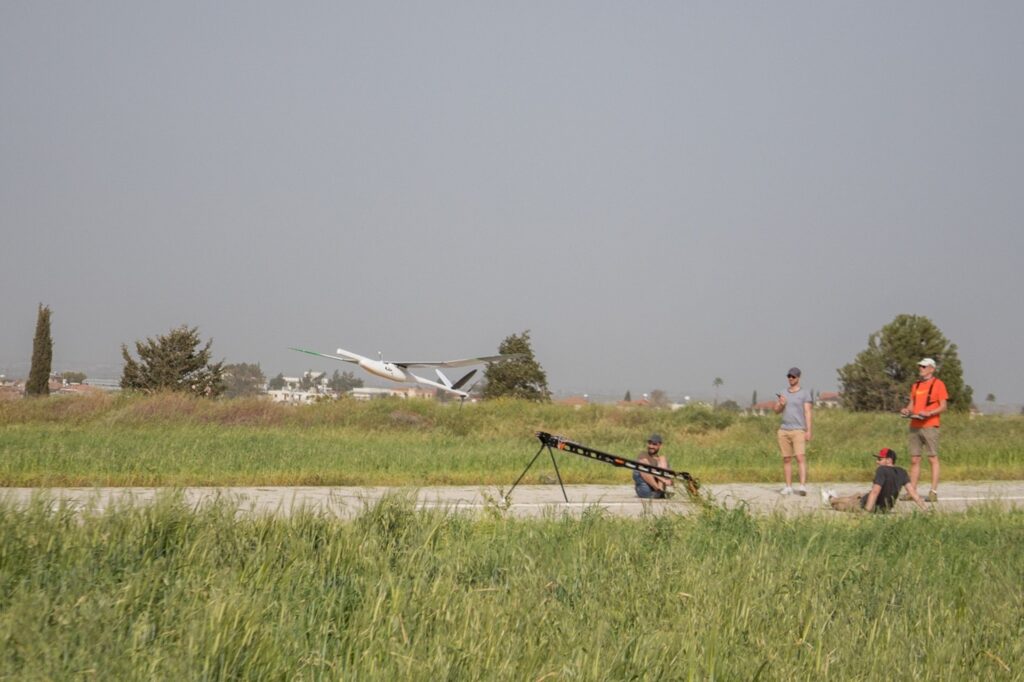
CARE-C campaign with the Environmental Physics group of the University of Tübingen at the Unmanned Systems Research Laboratory
The Environmental Physics group from the University of Tübingen, Germany, visited Cyprus, in order to continue the scientific flight campaign that started two years ago, and was interrupted due to the restrictions imposed due to the COVID-19 pandemic. The group arrival coincided with an intensive, prolonged dust event in Cyprus, with increased interest from an environmental point of view.
The campaign occurred in the framework of the ACTRIS-IMP project (Aerosol, Clouds and Trace Gases Research Infrastructure, http://www.actris.net/), through which interested research groups from around the globe can utilize the CARE-C, The Cyprus Institute, (www.cyi.ac.cy/) infrastructure in Orounda for unmanned aerial operations. The Environmental Physics group (www.umphy.de) from the University of Tübingen is the first one to use the CARE-C’s Unmanned Systems Research Laboratory (USRL) premises as a transnational access point under the ACTRIS-IMP project.
The USRL (Unmanned Systems Research Laboratory, usrl.cyi.ac.cy) provides support for the flight operations, as well as on scientific support. In particular, scientific flights with two UCASS (Universal Cloud and Aerosol Sounding System) on board a URSL fixed-wing unmanned aircraft system (UAS), were performed inside and above the dust layer. These airborne observations will be used for inter-comparison purposes.
The Environmental Physics group from the University of Tübingen adds both multicopter and fixed-wing UAS measurements of atmospheric dust, atmospheric electrical charges, thermodynamics, and turbulence. While the multicopters cover the lowest 500 m of the atmosphere, the flights with the fixed-wing UAS of type MASC-3 flights are alternating with the URSL aeroplane and probe the atmosphere up to 5500 m, in order to observe the temporal development of the lower atmosphere throughout the day.
During Saharan dust episodes over the Mediterranean, particles are typically transported from North Sahara to Cyprus within the lower half of the troposphere. Saharan dust plays an important role in climatology (e.g. diming sun light, changing albedo of the atmosphere and surfaces) and as fertilizer in ecosystems like the Amazon rainforest. Dust has an impact on air quality and thus has a negative impact on health.
Saharan events are also observed in Central Europe e.g. during 2022, large amounts of Sarahan dust affected South-West Germany already twice for several days each, degraded air quality, caused hazy skies and covered all kind of outdoor surfaces.
The measurement flights in Cyprus from 6th to 13th April, 2022, show the development of the lower half of the troposphere with respect to wind, temperature, water vapour, and the vertical distribution of dust particles over the day. For example, during the first research flight on 6th April, the PM10 data (counting all particles smaller than 10 microns) shows several regimes of dust:
Below 1500 m down to the ground, the dust was well mixed. Here we expect a mixture of locally produced dust from Cyprus and down-mixed Saharan dust. Above 1500 m, the data show first a decrease and then an almost linear increase of dust particle concentrations smaller than 10 microns. This indicates that part of the Saharan dust is mixed downwards. Since the atmosphere was mainly thermally stably stratified, the downward mixing was caused by small-scale and intermittent turbulence only.
A distinct Saharan dust layer (or Saharan air layer SAL), with quite sharp upper and lower limits, was observed between 1800 and 2500 m. Above the Saharan dust layer, the troposphere was almost clean, showing very low dust concentrations.
The goal of the upcoming data analysis is to quantify in detail the vertical transport processes of dust in the troposphere. The two sources of dust are 1) the land surface from which dust is taken up by convection and strong turbulence into the lower atmosphere, and 2) the Saharan dust layer from which dust is transported not only horizontally by wind but also vertically by small-scale turbulence. In order to distinguish Saharan dust from locally produced dust in the ABL, the size distributions of dust particles will be examined at the various altitudes and within the different atmospheric layers.

This activity has been supported by the ACTRIS-IMP project (2020-2023) which has received funding from the European Union’s Horizon 2020 research and innovation programme under grant agreement 871115.




